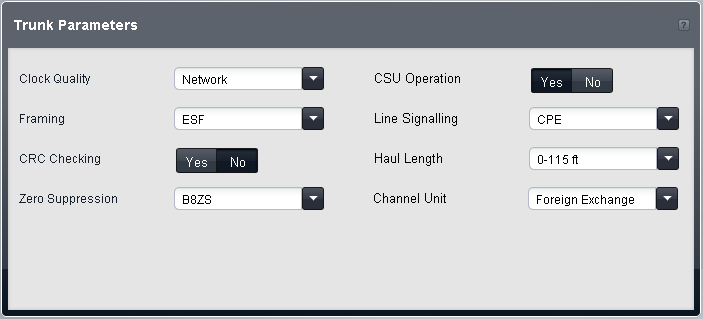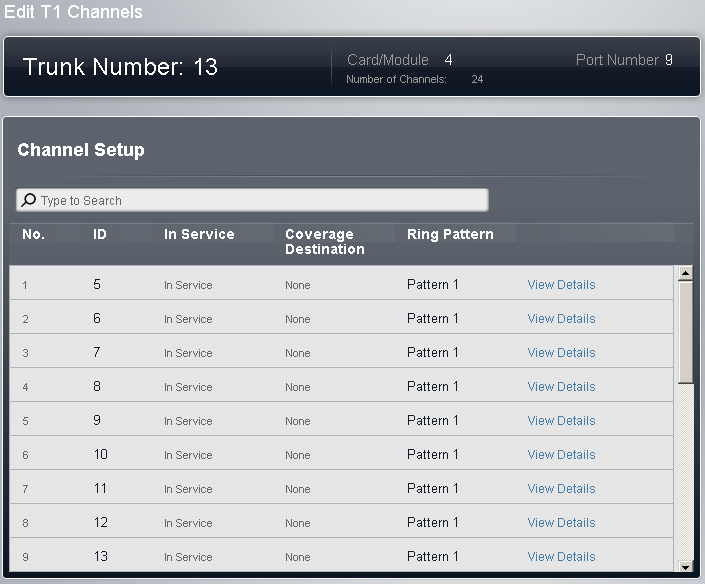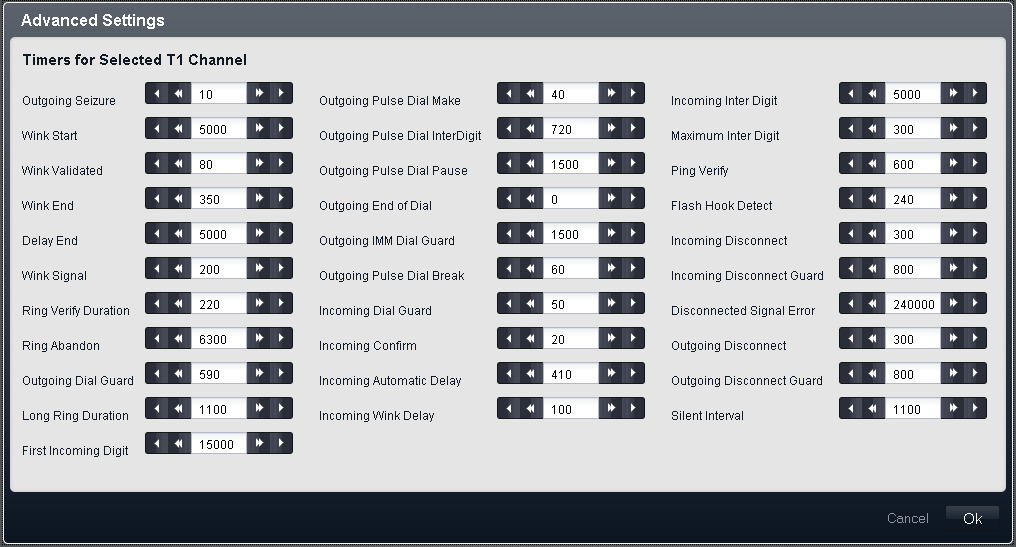This menu is accessed by clicking the View Details link adjacent to a trunk in the Installed Trunks table.

•! WARNING - Reboot Required
Changing any of these settings requires the system to be rebooted for the changes to take effect. Rebooting the system will end all calls currently in progress.
•Clock Quality: Default = Network
Leave as Network unless advised otherwise by Avaya.
•Framing: Default = ESF
Selects the type of signal framing used (ESF or D4).
•CRC Checking: Default = On
Turns CRC on or off.
•Zero Suppression: Default = B8ZS
Selects the method of zero suppression used (B8ZS or AMI ZCS).
•CSU Operation:
Tick this field to enable the T1 line to respond to loop-back requests from the line.
•Line Signaling: Default = CPE
The field can be set to either CPE (Customer Premises Equipment) or CO (Central Office). This field should normally be left at its default of CPE. The setting CO is normally only used in lab back-to-back testing.
•Haul Length: Default = 0-115 feet
Sets the line length to a specific distance.
•Channel Unit: Default = Foreign Exchange
This field should be set to match the channel signaling equipment provided by the Central Office. The options are Foreign Exchange, Special Access or Normal.
T1 Channels
This menu is accessed by selecting the trunk in the Installed Trunks table and then clicking on the ![]() edit icon in the Channel Setup panel on the right.
edit icon in the Channel Setup panel on the right.

•! WARNING - Reboot Required
Changing any of these settings requires the system to be rebooted for the changes to take effect. Rebooting the system will end all calls currently in progress.
•No: For information only, not editable.
•ID/Line Appearance ID: Default = Auto-assigned
This number is used to uniquely identify the telephone line or channel. The number can be assigned to programmable buttons on extensions to allow the users to make and answer calls on that line or channel.
•In Service: Default = Out of Service.
The setting can be used to sets whether the trunk channel is in use.
•Coverage Destination: Default = None.
This option sets where incoming calls should alert in addition to alerting on those extension that have a line appearance button programmed for the line. When the phone system is in night service mode, calls alert at the members of the Night Service group.
•None |
|
•Extension |
|
•Phantom Extension |
|
•Hunt Group |
|
•Calling Group |
|
•Operator Group |
|
•Voicemail |
•Ring Pattern: Default = 1.
Selects the ring pattern that should be used for calls when alerting on an extension. Calls forwarded, sent to call coverage or to a hunt group will always use the line ring pattern. Calls direct to an extension will use the line ringing pattern unless the user has Override Line Ringing set. Not used for calls presented to the user as a member of the Operator group. This feature is also not used for BST phones.
T1 Channel Setup
This menu is accessed by selecting the trunk in the Installed Trunks table and then clicking on the ![]() edit icon in the Channel Setup panel on the right. Select the required channel and then click on View Details.
edit icon in the Channel Setup panel on the right. Select the required channel and then click on View Details.

•! WARNING - Reboot Required
Changing any of these settings requires the system to be rebooted for the changes to take effect. Rebooting the system will end all calls currently in progress.
VMS Settings
These settings are used to control when and how quickly the system will use one of its auto attendants to answer a currently unanswered call.
•! WARNING - Reboot Required
Changing any of these settings requires the system to be rebooted for the changes to take effect. Rebooting the system will end all calls currently in progress.
•Delay - Day: Default = 2. Range = 0 to 6 (number of rings).
Set the number of rings before an unanswered call should be redirected the selected auto attendant when the system is not running in night service mode and the VMS Schedule is set to Always or Days Only.
•Delay - Night: Default = 2. Range = 0 to 6 (number of rings).
Sets the number of rings before an unanswered call should be redirected to the selected auto attendant when the system is running in night service mode and the VMS Schedule is set to Always or Night Only.
•Schedule: Default = Never.
This option determines when the VMS Delay settings above should be used and unanswered calls redirected to the selected auto attendant. The options are:
•Always
Redirect calls when the system is in both day and night service modes.
•Day Only
Redirect calls only when the system is not in night service.
•Night Only
Redirect calls only when the system is in night service.
•Never
Do not redirect calls.
•Auto Attendant: Default = Auto Attendant 1.
This field allows selection of which auto attendant is used.
Type Settings
•No: For information only, not editable.
•ID/Line Appearance ID: Default = Auto-assigned
This number is used to uniquely identify the telephone line or channel. The number can be assigned to programmable buttons on extensions to allow the users to make and answer calls on that line or channel.
•Type: Default = Out of Service
The T1 emulates the following connections (Ground Start, Loop Start, E & M - TIE, E & M - DID, E & M Switched 56K, Direct Inward Dial, Clear Channel 64K or Out of Service). Trunks set to E & M - DID will only accept incoming calls. If E&M - TIE is selected and the Outgoing Trunk Type is set to Automatic, no secondary dial tone is provided for outgoing calls on this channel.
•Incoming Trunk Type: Default = Wink-Start
Used for E&M types only. The handshake method for incoming calls (Automatic, Immediate, Delay Dial or Wink-Start).
•Outgoing Trunk Type: Default = Wink-Start
Used for E&M types only. The handshake method for outgoing calls (Automatic, Immediate, Delay Dial or Wink-Start).
Gains
These settings are used to adjust the signal received and sent by the system.
•Tx Gain: Default = 0dB
Sets the transmit gain applied to the outgoing signal sent from the system.
•Rx Gain: Default = 0dB
Sets the receive gain applied to the incoming signal received by the system.
T1 Advanced Channel Setup
This menu is accessed by clicking the Advanced button on the channel setup menu. Only adjust these values under guidance from the line provider.

•! WARNING - Reboot Required
Changing any of these settings requires the system to be rebooted for the changes to take effect. Rebooting the system will end all calls currently in progress.
